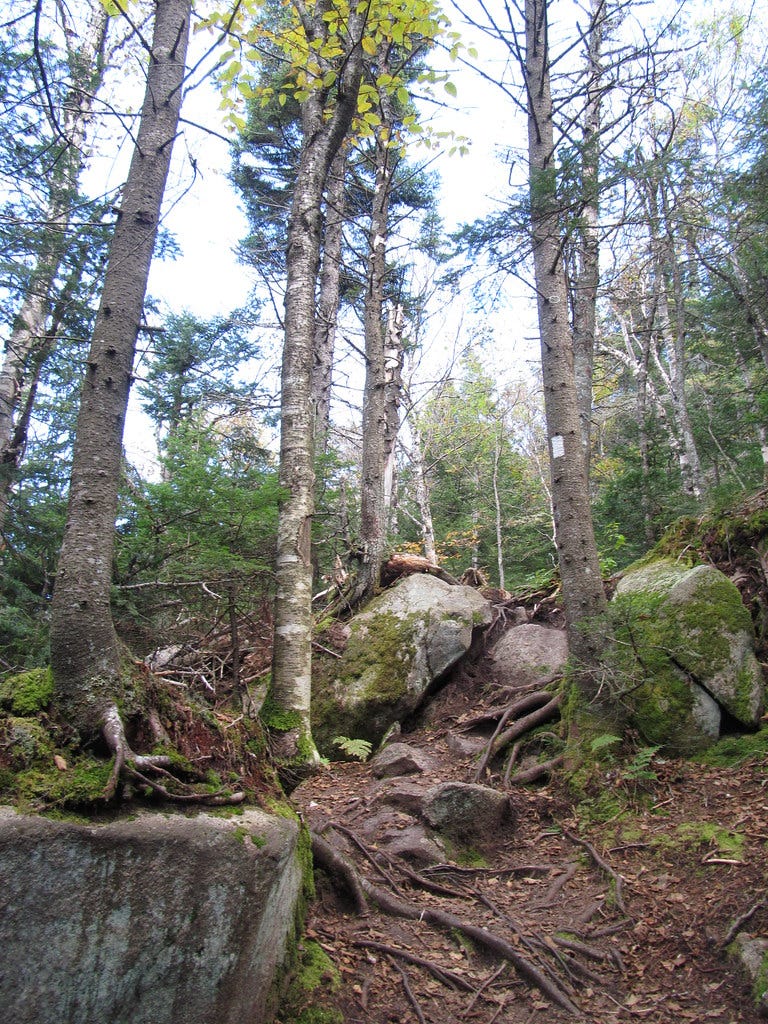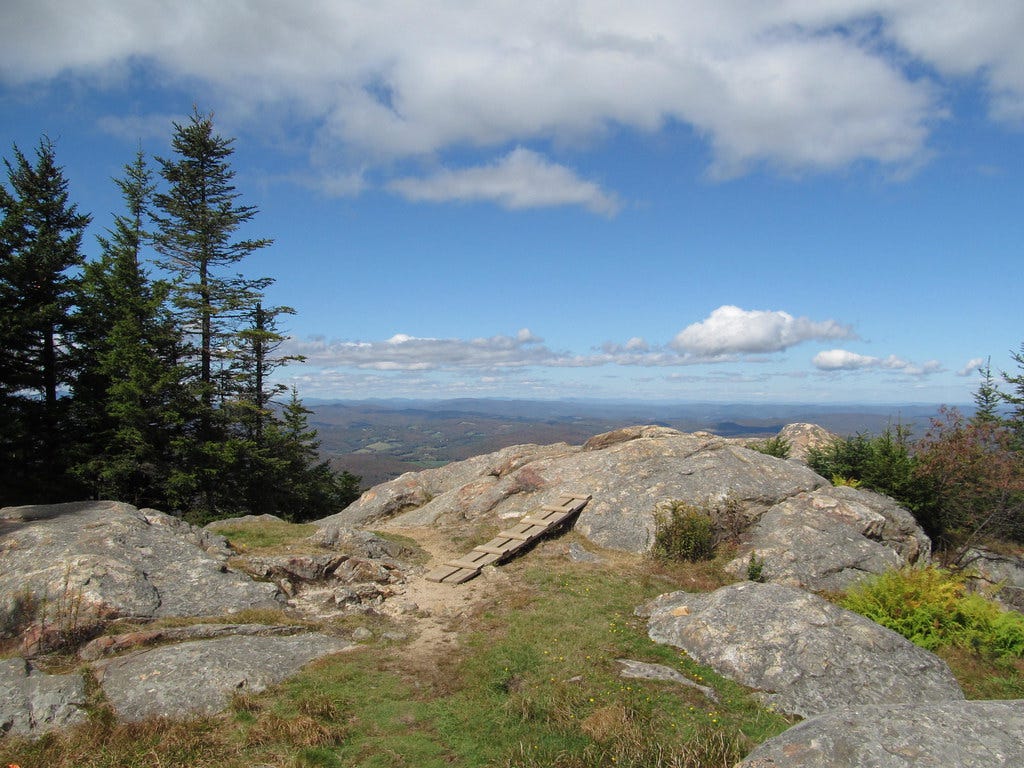The mountain is my muse
Artists, hang-gliders, and Charles Bronson can't be wrong!
Imagine a reality in which every morning, whenever you walked out of your front door or opened the curtains in your living room, you were greeted with the sight of a lonely mountain looming over the landscape—a citadel of conifers, mosses, and boulders. There are no other comparable mountains nearby to mute the visual impact of this towering peak. The mountain is a singular wonder, and it’s always there. Would you become so used to this mountain that seeing it would eventually fail to excite you? Would the mountain slowly drive you mad, to the point where you’re at a family dinner and you’re using a spoon to sculpt your mashed potatoes into a miniature mountain?
Or would the mountain open up a portal to a new dimension of ideas and inspiration?
On the eastern edge of southern Vermont, where the Connecticut River forms a natural barrier between the Green Mountain State and New Hampshire, there is a solitary and shapely mountain which has ensnared creative minds for years—with beautiful results for those of us who appreciate classical art *and* the art of death-defying spectacles.
The great beauty that I’m talking about here is Mount Ascutney; a 3,144 monadnock comprised of igneous rocks, named for the nearby juncture where New Hampshire’s Sugar River spills into the Connecticut River. (It’s a western aberration of the Abenaki word “Ascutegnik,” which translates to “at the end of the river fork.”) The summit of Mount Ascutney is the highest point in Windsor County, Vermont, and that’s why the hulking profile of Ascutney has a such a commanding presence in the area. This is a mountain that cannot be avoided. And of all the people who’ve called the Ascutney foothills home in recent centuries, few relished the presence of the mountain like Augustus Saint-Gaudens, the American sculptor who created some of our most iconic Civil War memorial works (including the sculpture on Boston Common depicting the mostly Black 54th Regiment of Massachusetts and its colonel, Robert Gould Shaw.)
The studios in which Saint-Gaudens and his team of apprentices cranked out various commissioned works is located on the Granite State side of the Connecticut River, on a height of land that offers an ecstatic view of Mount Ascutney. Today those studios are part of the Saint-Gaudens National Historic Site, and when you walk across the grounds of the late sculptor’s combined workplace and homestead, you realize how everything is laid out in a way that offers unobsructed access to that sweet Mount Ascutney vista—as though the stunning sight of the mountain was a well of creative energy that Saint-Gaudens tapped into periodically. And he wasn’t alone in doing this. The painters Maxfield Parrish and Charles Platt also built homes within sight of the lonesome mountain, as did the American novelist Winston Churchill, who wrote page turners such as Mr. Keegan’s Elopement in the early 1900s, back when the Winston Churchill most of us know was finding his liberal side in the House of Commons.
I love this idea of a natural landmark imbuing the people nearby with a special energy; real or perceived! New York Mayor Eric Adams talked about this in 2022, arguing that the city derives its special vibe from a big deposit of gemstones that are buried deep in the bedrock beneath Manhattan. (In my opinion, this says more about Eric Adams than New York.) These days, Mount Ascutney might not be the shit-hot landmark for creatives as it once was, but the peak still inspires and attracts noteworthy visitors. The granite outcroppings on the mountain’s haunches have become a popular “jump zone” for hang-gliders. And it was the possibility of watching hang-gliders taking that stomach plunging leap of faith into the abyss that inspired me to finally go for a hike on Ascutney two summers ago. My introduction to the mountain had happened earlier that year, on a media visit to the Saint-Gaudens National Historic Site. I was no longer content to simply gawk at Mount Ascutney. I wanted to feel the mountain in my soles and under my fingernails. I wanted to be inspired by the mountain and humbled by it.
The menu of trails to the top of Mount Ascutney is invitingly diverse. I considered the brevity and rock scrambling of the Windsor Trail, or the heftier scale and the ancient logging machinery found alongside the Futures Trail. But in the end, I settled upon the 2.9-mile Weathersfield Trail for two reasons. After heavy rains, the Weathersfield Trail features some charming waterfalls. And it also runs past the mountain’s West Peak, which is where the hang-gliders push off. Often these jump spots for hang-gliders are secluded and challenging to reach, but in this case, I could just sit there, eating some Cheetos as someone in a flight suit fastened their helmet and prepared to dance with death. That, in itself, would be a special communion worth hiking Mount Ascutney for.
But there’s another reason to climb a mountain that’s served as a source of inspiration for creative geniuses. It’s easy to settle for the romantic portrait of a mountain, upon which we can project our dreams or from which we can mine them. But how many of us push beyond the image of an iconic mountain and experience the feral beauty of its woods, gulches, and crags? When I arrived at the Weathersfield Trail parking lot at 9AM on a Saturday in September, I was still holding onto this conception of Mount Ascutney as a divine being. One hour later, I was wheezing my way up slick rock stairs flanked by deciduous beech and maple trees, past mossy boulders and mini gorges, reveling in it all as Mount Ascutney mercilessly whipped my ass. Beneath the canopy and the hallowed stories surrounding it, Mount Ascutney was a freak. And I loved it.
There can be a beauty in suffering, as New Englanders know and appreciate, and I guess it’s fitting that when I finally reached gusty overlook of West Peak, there were no hang-gliders present that day. I may have timed my visit a few weeks too late in the season, and I had to settle for sitting there, moping and drowning my sorrows by drinking in the still-impressive view of the valley below. Not far from here, a wooden observation tower offers an even better outlook, though it’s not located on the true summit. Unfortunately, that piece of real estate is now occupied by a metal satellite tower. After decades worth of artists harnessing the power of Ascutney, thousands of people are tapping into a literal signal from the peak, through their television boxes.
But—fittingly enough—one person whose movies you might be able to watch via the Mount Ascutney satellite tower was a latter day admirer of the mountain. When he wasn’t busy shooting burglars and bandits, Charles Bronson spent years recuperating from the madness of filmmaking in the shadow of Ascutney. He owned a 400-acre property in the town of West Windsor, Vermont, and when he passed away in 2003, Bronson’s family laid him to rest in a cemetery that Mount Ascutney towers above, like a doting babysitter. And if you’re seeking out Windsor County’s great mountain with the intent of understanding what captivated all those artists and thrill-seekers, you might consider following your hike with a ruminative visit to Bronson’s grave.
At least, that’s what I did after my hike. I puttered over to Brownsville Cemetery and spent 10-15 minutes tracking down the headstone of the legendary vigilante killer. I wondered what was going through the mind of Charles Bronson during his later years on the farm, long after the Death Wish franchise had devolved from a semi-intelligent revenge thriller into a series of mindless and ghoulish sequels for folks who salivate at the thought of gunning down street criminals. The sequels were panned by critics and the box office receipts dwindled with each entry. Did Bronson find solace from this, when presented with the profile of Mount Ascutney? Did he rationalize the shitty sequels when gazing upon Ascutney? (A privilege for which he paid property taxes.) Or was he completely unbothered by this? The allure of a mountain like Ascutney can never be easily explained. But the mountain itself can be a canvas for our wonderings.
Mount Ascutney via the Weathersfield Trail
Hike distance: 5.8 miles out-and-back
Elevation gain: 2,185 feet
CLICK HERE for a trail map
If any of you are traveling to Portugal in the near future and would like to avoid doing the same things that most travelers do in Portugal, I’ve got you covered. According to this AFAR article from Bailey Berg, the first segment of the Palmilhar Portugal trail (translation: the “Walking Portugal” trail) has opened to the public. Once finished, the trail will form a 2,000-ish mile circle around Portugal, making it the longest loop trail in the world. Like Berlin’s 66 Lakes Trail or Spain’s Camino de Santiago for that matter, the route is a curation of trails and roads which will form the epic circle once the work is completed. That’s expected to happen in December, so this is a rare opportunity to be a trail hipster and experience a hefty slice of Palmilhar Portugal before it’s A Thing.
Fellow hiker and chronicler of hiking Jessica McKenzie has a great review of the new film Good One in her newsletter, Pinch of Dirt. This was actually the first I had heard of Good One and after reading Jessica’s review, I immediately booked an advance ticket for a screening at Coolidge Corner Theater, where it’s now playing. Set on a weekend backpacking trip in the Catskills, the movie (directed by India Donaldson) centers its 17 year-old protagonist, Sam as she “navigates the clash of egos between her father and his oldest friend.” I’m quoting the official film synopsis here because the less you know about Good One from the outset, beyond its premise, the better. In fact, if you want to go in relatively blank, you should read the first part of Jessica’s review now and save the rest for later. All I’ll say is that backpacking movies, of which there are not many, almost never manage to stick the landing. This is a rare, bracing winner.
Lastly, speaking of backpacking, I’m finally watching The Last Of Us, in which the world has been ravaged by the cordyceps fungus adapting to a warming world and jumping from insects to humans. (It’s a backpacking show because the first season follows two survivors making a harrowing journey across the ruined U.S. landscape in search of potential salvation.) And it got me thinking…what are some other elements of the natural world that could potentially be weaponized against mankind one day? I’m thinking broadly here. A forgotten fault line or volcano that we never talk about. An ailment that hasn’t figured out how to permeate humans yet. A weather event or the transformation of a system that would throw our world into chaos. If any one of these things is your nightmare, I’d like it to become my nightmare too. Please get in touch.







